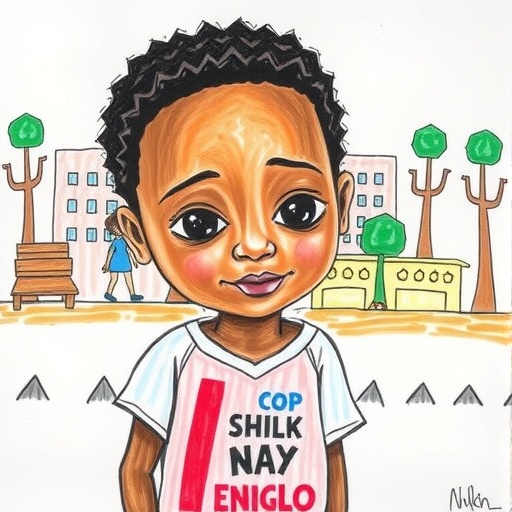Urban child poverty is a significant global issue that captures the attention of researchers and policymakers alike. Within this context, a groundbreaking study led by Kwiringira, Okimait, and Perry offers a unique perspective on the lived experiences of children in Kampala, Uganda, through their artistic expressions. By analyzing the intricate and often poignant drawings created by children, the research aims to shed light on the multifaceted nature of urban child poverty in this vibrant city, highlighting the issues faced by young residents and the urgent need for action.
The researchers embarked on this innovative approach by inviting children from diverse backgrounds in Kampala to express their thoughts and feelings related to poverty through drawing. This methodology is particularly insightful, as it taps into the children’s creativity, allowing them to communicate their challenges and aspirations without the constraints of language or complex socio-economic terminologies. Such engagement offers a window into their world, illuminating the stark realities of life in an urban landscape marked by inequality and hardship.
In analyzing the children’s artwork, the researchers identified common themes reflecting their struggles—housing insecurity, access to education, and inadequate healthcare. These images often depicted dilapidated structures, overcrowded living conditions, and scenes of children scavenging for resources. The emotional weight of these drawings serves as a powerful testimony to the children’s distress and resilience in the face of adversity. This qualitative data enriches traditional quantitative measures of poverty, offering a more holistic understanding of the children’s lived realities.
The study also emphasizes the importance of children’s voices in the narrative surrounding urban poverty. Often relegated to the sidelines in discussions about socio-economic conditions, children’s perspectives are crucial for developing effective policies and interventions. Their insights call for a more child-centered approach to urban planning and resource allocation, ensuring that strategies to combat poverty reflect the needs and experiences of the most affected demographic—children themselves.
Drawing as a medium fosters not only individual expression but also community engagement. The artwork produced by these children sparked dialogue among parents, educators, and local authorities, facilitating discussions that might not have otherwise occurred. This community involvement is vital as it fosters a collective understanding of the issues at hand, encouraging local stakeholders to collaborate on sustainable solutions to alleviate poverty.
Furthermore, the research highlights the varying degrees of impact that urban poverty has on children depending on their geographical location within Kampala. The differences in resources, opportunities, and social services available in different districts underscore the need for localized responses to child poverty. Implementing tailored interventions that address the unique challenges faced by children in distinct neighborhoods can enhance the efficacy of poverty alleviation strategies, making them more responsive and relevant to the population they aim to serve.
Additionally, the findings underscore the interplay between urban planning and child development. The researchers argue that as cities continue to grow and modernize, it becomes crucial for urban planners to prioritize children’s needs. Integrating child-friendly spaces within community designs can foster healthier environments where children can thrive. This approach not only enhances the physical landscape but also contributes to the emotional and psychological well-being of urban children.
The researchers also advocate for greater investment in educational programs that empower children to express themselves creatively. Education plays a pivotal role in breaking the cycles of poverty, and when children are equipped with the skills to articulate their experiences, they become active participants in shaping their futures. Schools can serve as incubators for creativity, encouraging children to explore their feelings about poverty and their aspirations for a better life through various artistic mediums.
Moreover, this study aligns with broader global discourses on child rights and social justice. As the international community increasingly recognizes the importance of prioritizing children’s voices in development agendas, the insights gained from this research can inform policies aimed at eradicating child poverty. By championing the inclusion of children’s artistic expressions in policy discussions, stakeholders can strive for a more equitable society that values and uplifts the youngest members of urban populations.
As the researchers conclude, understanding urban child poverty requires looking beyond statistics and economic indicators. The lived experiences of children, conveyed through their drawings, present a powerful narrative that advocates for systemic change. Efforts to combat child poverty must be informed by the realities children face daily, ensuring that their rights to a safe and supportive environment are met.
In summary, the study conducted by Kwiringira, Okimait, and Perry reveals profound insights into the world of urban child poverty in Kampala. Through the eyes of children, we are reminded of the need to reconsider our approaches to poverty alleviation, emphasizing the essential role that children play in these discussions. Their artistic expressions not only illuminate their struggles but also offer hope — a call to action for future generations to address the deep-rooted issues of inequality and injustice affecting urban landscapes worldwide.
Ultimately, this study serves as a clarion call for researchers, policymakers, and communities to embrace innovative methods of understanding and addressing child poverty. By valuing the voices of children and fostering their creative expressions, we can work towards a future where all children thrive, regardless of their socio-economic status.
Subject of Research: Urban child poverty in Kampala city as expressed through children’s drawings.
Article Title: Urban child poverty in Kampala city, insights from children’s drawings.
Article References:
Kwiringira, J.N., Okimait, D., Perry, E.W. et al. Urban child poverty in Kampala city, insights from children’s drawings.
Discov glob soc 3, 128 (2025). https://doi.org/10.1007/s44282-025-00276-4
Image Credits: AI Generated
DOI: https://doi.org/10.1007/s44282-025-00276-4
Keywords: Urban child poverty, children’s drawings, qualitative research, Kampala, socio-economic conditions, community engagement, child rights, educational programs, urban planning, creative expression.




